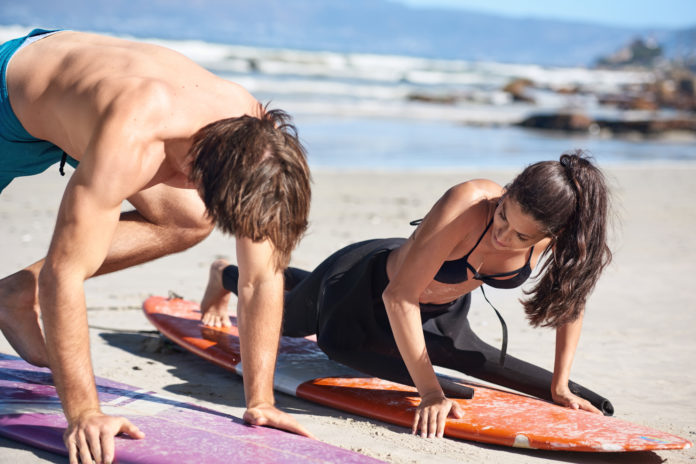In 2020, it’s predicted that 50 million people will surf worldwide.
Thanks to surfing debuting at the Olympics and the cool image associated with the sport, many of us are keen to try surfing for beginners.
Are you excited to carve waves but you’re not 100% where to start? If so, you’ve come to the right place. Here’s everything you need to know.
Table of Contents
Don’t Learn Alone
One of the top surfing tips for beginners is to get someone to teach you. It could be an experienced friend or a surf camp, but it’s essential to learn the basics to avoid injuring yourself and others when you’re out there.
If you decide on surf lessons, research an excellent teacher first. Make sure they’re experienced, have good reviews, and a great attitude so they inspire you to love surfing.
How to Choose Your First Surfboard
Tips for beginner surfers include getting the right surfboard. You’ll most likely start with a soft-top, or “foamie”, which got its name because it’s covered with a spongey EVA skin.
Foamies are fantastic as they’re less likely to hurt you or others in a collision compared to traditional hard, fiberglass boards. But it’s important to note that you’ll progress to a better quality board once you’ve covered the basics.
Get the Right Wetsuit
Before learning how to surf for beginners, get your first wetsuit. It’s also possible to hire them but they’re often worn through and end up leaking.
Most wetsuits for women and men come in a range of thicknesses, including 3:2 for summer, 4:3 for in-between seasons, and 5:4 for winter.
You’ll also notice there are back zip or chest zip wet suits which is down to personal choice. Many beginner surfers prefer the chest zip as their chest and back are shielded so less water gets in. Further, chest zip wetsuits make it easier to paddle compared to back zip suits.
Find the Best Beginner Spot to Surf
To learn how to surf better, find the perfect beginner spot. You’ll want the waves to break slowly, long rows of knee-high whitewater coming towards the shore. The key is to find a less crowded spot, where you can catch plenty of waves, and get comfortable on the board.
Practice On Dry Land
Surfing for dummies tip: never rush into the water.
Take time on the beach to stretch, check your leash, board, and consider the waves. Watch other surfers and analyze their techniques.
You should also practice on the beach first. Lay down your surfboard, on your stomach, and then burst off the ground by using the force from your hands and feet.
Surfers who are regular-footed should place their left foot nearer the surfboard’s nose, and their right foot behind. And vice-versa. Practice by doing five sets of 20 reps so you improve your balance and quickness.
Just Keep Paddling
Most surfers would agree that paddling is the most physically demanding aspect of the sport. Find a rhythm before the waves sweep underneath you, so you can get back out there.
As a rule of thumb, use short strokes to angle your board and make 10 strong paddles before you reach the wave’s peak. You should cup your hands and grab the water beneath your board and keeping your forearms perpendicular to it.
It’s important to remain calm and understand it takes a few tries to get used to paddling.
Stay In The Right Position
Once you’re on the surfboard, keep to the center otherwise you’ll fall either way. Straddle the centerline with your feet’s arches so your toes point towards the side of the board. And remember to keep your feet a little more than a shoulder-width apart.
Catch Your First Wave
When the wave approaches, lie front-down on your board and paddle towards the shore. Use strong strokes and stay perpendicular to the wave, with your board pointed in the direction you want to go.
Once the wave picks you up, push down on the board and jump to your feet. You should always stand sideways and make sure your back foot is over the board’s fins. Your front foot should be under your chest, pointing forward.
Aim your board towards the wave’s shoulder and let it guide you.
Learn to Duck Dive
An essential skill every surfer must learn is duck diving. You may encounter less worthy waves to surf so duck diving lets you slip beneath it before the waves breaks.
When you’re eight feet from an oncoming wave, grab your board on either side and push onto your knees. Throw your weight forward, kicking up one of your legs with your knee bent at 90 degrees.
You should then force your board’s nose down and under the wave to avoid getting wiped out.
Love the Learning Process
That said, you must also, learn to actively fall. For instance, kick your board away or tumble towards the wave’s shoulder to avoid the board smacking against your head.
You should never dive off your board headfirst and avoid falling under a wall of waves because that’s when it’s most powerful.
Those Are Our Surfing For Beginners Tips
Surfing for beginners is a fantastic time to choose the right surfboard, wet suit, and learn how to stand on your board. It’s important to practice on dry land first and find a less crowded spot with smaller waves so you can ease yourself into it.
Also, always fall actively and throw your board away to prevent any injuries. Happy carving!
Did you find this article helpful? If so, check out our posts on everything from family to vaping.
















